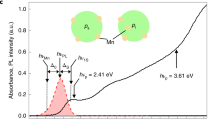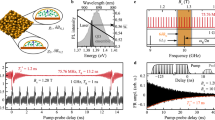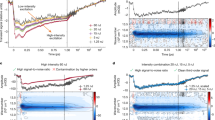Abstract
‘Motional narrowing’ refers to the striking phenomenon where the resonance line of a system coupled to a reservoir becomes narrower on increasing the reservoir fluctuation. A textbook example is found in nuclear magnetic resonance, where the fluctuating local magnetic fields created by randomly oriented nuclear spins are averaged when the motion of the nuclei is thermally activated. The existence of a motional-narrowing effect in the optical response of semiconductor quantum dots remains so far unexplored. This effect may be important in this instance because the decoherence dynamics is a central issue for the implementation of quantum information processing based on quantum dots. Here we report on the experimental evidence of motional narrowing in the optical spectrum of a semiconductor quantum dot broadened by the spectral-diffusion phenomenon. Surprisingly, motional narrowing is achieved when decreasing incident power or temperature, in contrast with the standard phenomenology observed for nuclear magnetic resonance.
This is a preview of subscription content, access via your institution
Access options
Subscribe to this journal
Receive 12 print issues and online access
$209.00 per year
only $17.42 per issue
Buy this article
- Purchase on Springer Link
- Instant access to full article PDF
Prices may be subject to local taxes which are calculated during checkout




Similar content being viewed by others
References
Bloembergen, N., Purcell, E. M. & Pound, R. V. Relaxation effects in nuclear magnetic resonance. Phys. Rev. 73, 679–715 (1948).
Kubo, R. in Fluctuation, Relaxation and Resonance in Magnetic Systems (ed. Ter Haar, D.) 23–68 (Oliver and Boyd, Edinburgh, 1962).
Dyakonov, M. I. & Perel, V. I. Spin orientation of electrons associated with the interband absorption of light in semiconductors. Sov. Phys. JETP 33, 1053–1059 (1971).
Oxtoby, D. W. Hydrodynamic theory of vibrational dephasing in liquids. J. Chem. Phys. 70, 2605–2610 (1979).
Eberly, J. H., Wódkiewicz, K. & Shore, B. W. Noise in strong laser-atom interactions: Phase telegraph noise. Phys. Rev. A 30, 2381–2389 (1984).
Flach, R., Hamilton, D. S., Selzer, P. M. & Yen, W. M. Time-resolved fluorescence line-narrowing studies in LaF3:Pr3+. Phys. Rev. Lett. 35, 1034–1037 (1975).
Ambrose, W. P. & Moerner, W. E. Fluorescence spectroscopy and spectral diffusion of single impurity molecules in a crystal. Nature 349, 225–227 (1991).
Empedocles, S. A., Norris, D. J. & Bawendi, M. G. Photoluminescence spectroscopy of single CdSe nanocrystallite quantum dots. Phys. Rev. Lett. 77, 3873–3876 (1996).
Robinson, H. D. & Goldberg, B. B. Light-induced spectral diffusion in single self-assembled quantum dots. Phys. Rev. B 61, R5086–5089 (2000).
Besombes, L., Kheng, K., Marsal, L. & Mariette, H. Few-particle effects in single CdTe quantum dots. Phys. Rev. B 65, 121314 (2002).
Kammerer, C. et al. Interferometric correlation spectroscopy in single quantum dots. Appl. Phys. Lett. 81, 2737 (2002).
Gérard, J. M. et al. Optical investigation of the self-organized growth of InAs/GaAs quantum boxes. J. Cryst. Growth 150, 351–356 (1995).
Heitz, R. et al. Observation of reentrant 2D to 3D morphology transition in highly strained epitaxy: InAs on GaAs. Phys. Rev. Lett. 78, 4071–4074 (1997).
Shah, J. Ultrafast Spectroscopy of Semiconductors and Semiconductor Nanostrutures (Spinger, Berlin, 1998).
Lohner, A., Woerner, M., Elsaesser, M. & Kaiser, W. Picosecond capture of photoexcited holes by shallow acceptors in p-type GaAs. Phys. Rev. Lett. 68, 3920–3923 (1992).
Carroll, J.E. Rate Equation in Semiconductor Electronics (Cambridge Univ. Press, 1985).
O’Hara, K. E., Gullingsrud, J. R. & Wolfe, J. P. Auger decay of excitons in Cu2O. Phys. Rev. B 60, 10872–10885 (1999).
Jusserand, B. & Cardona, M. in Light Scattering in Solids V (eds Cardona, M. & Guntherrodt, G.) 49–152 (Springer, Heidelberg, 1989).
Knill, E., Laflamme, R. & Milburn, G. J. A scheme for efficient quantum computation with linear optics. Nature 409, 46–52 (2001).
Santori, C., Fattal, D., Vučković, J., Solomon, G. S. & Yamamoto, Y. Indistinguishable photons from a single-photon device. Nature 419, 594–597 (2002).
Bylander, J., Robert-Philip, I. & Abram, I. Interference and correlation of two independent photons. Eur. Phys. J. D 22, 295–301 (2003).
Kammerer, C. et al. Line narrowing in single semiconductor quantum dots: Toward the control of environment effects. Phys. Rev. B 66, 041306 (2002).
Urbaszek, B. et al. Temperature-dependent linewidth of charged excitons in semiconductor quantum dots: Strongly broadened ground state transitions due to acoustic phonon scattering. Phys. Rev. B 69, 035304 (2004).
Ortner, G. et al. Temperature dependence of the zero-phonon linewidth in InAs/GaAs quantum dots. Phys. Rev. B 70, 201301 (2004).
Borri, P. et al. Exciton dephasing via phonon interactions in InAs quantum dots: Dependence on quantum confinement. Phys. Rev. B 71, 115328 (2005).
Besombes, L., Kheng, K., Marsal, L. & Mariette, H. Acoustic phonon broadening mechanism in single quantum dot emission. Phys. Rev. B 63, 155307 (2001).
Borri, P. et al. Ultralong dephasing time in InGaAs quantum dots. Phys. Rev. Lett. 87, 157401 (2001).
Favero, I. et al. Acoustic phonon side-bands in the emission line of single InAs/GaAs quantum dots. Phys. Rev. B 68, 233301 (2003).
Acknowledgements
We thank A. Jankovic, C. Ciuti and B. Gayral for discussions. LPA-ENS is ‘unité mixte (UMR 8551) de l’ENS, du CNRS, des Universités Paris 6 et 7’. This work is financially supported by the region Ile de France.
Author information
Authors and Affiliations
Corresponding author
Ethics declarations
Competing interests
The authors declare no competing financial interests.
Rights and permissions
About this article
Cite this article
Berthelot, A., Favero, I., Cassabois, G. et al. Unconventional motional narrowing in the optical spectrum of a semiconductor quantum dot. Nature Phys 2, 759–764 (2006). https://doi.org/10.1038/nphys433
Received:
Accepted:
Published:
Issue Date:
DOI: https://doi.org/10.1038/nphys433
This article is cited by
-
Observation of ~100% valley-coherent excitons in monolayer MoS2 through giant enhancement of valley coherence time
Light: Science & Applications (2023)
-
Ultra-low loss quantum photonic circuits integrated with single quantum emitters
Nature Communications (2022)
-
Tailoring the properties of quantum dot-micropillars by ultrafast optical injection of free charge carriers
Light: Science & Applications (2021)
-
Two-time correlation functions beyond quantum regression theorem: effect of external noise
Quantum Information Processing (2021)
-
Quantum teleportation using highly coherent emission from telecom C-band quantum dots
npj Quantum Information (2020)



